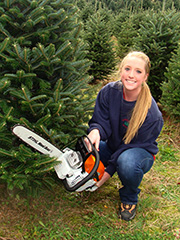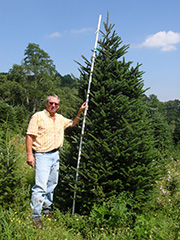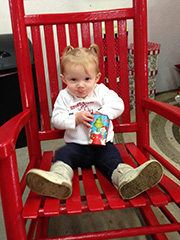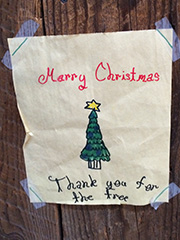When a Christmas tree is cut, over half of its weight is water. With proper care, you can maintain the quality of your displayed trees.
Below are a number of tips relating to the care of displayed trees.
- Displaying trees in water is the most effective way of maintaining their freshness and minimizing needle loss problems.
- In selecting a tree, make sure that the “handle” at the bottom is long enough to allow the trunk to fit into you tree stand. Otherwise, it will be necessary to remove large branches near the base, which could ruin its appearance.
 Make a fresh cut to remove a 1/4″ to 1″ thick disk of wood from the base of the trunk before putting the tree in the stand. Make the cut perpendicular to the stem axis. Don’t cut the trunk at an angle, or into a v-shape, which makes it far more difficult to hold the tree in the stand and also reduces the amount of water available to the tree. If you use a “center pin” stand, make sure the hole is drilled in the stem after it is trimmed.
Make a fresh cut to remove a 1/4″ to 1″ thick disk of wood from the base of the trunk before putting the tree in the stand. Make the cut perpendicular to the stem axis. Don’t cut the trunk at an angle, or into a v-shape, which makes it far more difficult to hold the tree in the stand and also reduces the amount of water available to the tree. If you use a “center pin” stand, make sure the hole is drilled in the stem after it is trimmed.- Once home, place the tree in water as soon as possible. Most species can go 6-8 hours after cutting the trunk and still take up water. Don’t bruise the cut surface or get it dirty.
- If needed, trees can be temporarily stored for several days in a cool location. Place the freshly cut trunk in a bucket that is kept full of water. The tree may need to be supported in some manner to keep if from tipping over.
- To display the trees indoors, use a stand with an adequate water holding capacity for the tree. As a general rule, stands should provide 1 quart of water per inch of stem diameter. Devices are available that help maintain a constant water level in the stand.
- Use a stand that fits your tree. Some stands have circular rings at the top,so the ring must be large enough for the trunk to go through the hole. Other stands are open, which may allow a greater range in trunk size. Avoid whittling the sides of the trunk down to fit a stand. The outer layers of wood are the most efficient in taking up water and should not be removed.
- Keep displayed trees away from sources of heat (fireplaces, heaters, heat vents, direct sunlight). Lowering the room temperature will slow the drying process, resulting in less water consumption each day.
- The temperature of the water used to fill the stand is not important and does not affect water uptake.
- Check the stand daily to make sure that the level of water does not go below the base of the tree. With many stands, there can still be water in the stand even though the base of the tree is no longer submerged in water.
- Drilling a hole in the base of the trunk does not improve water uptake.
- Applying film-forming anti-transpirants to the tree does not have a significant effect on the rate of moisture loss from the tree. These products supposedly block the evaporation of water from the surface of foliage, but in reality they have little effect.
- Adding water-holding gels to the stand is not beneficial and they can reduce the amount of water in the stand that is available to the tree.
- Do not use additives in the water, including floral preservatives, commercial tree preservatives, molasses, sugar, bleach, soft drinks, aspirin, honey, and other concoctions. Clean water is all that is needed to maintain freshness.
- Displaying trees in water with proper care is the most effective way of maintaining a tree’s moisture. Some flame retardants can damage needles and actually increase the rate of moisture loss from trees.
- Use of miniature lights will produce much less heat and reduce drying of the tree.
- Always inspect light sets prior to placing them on the tree. If worn, replace with a new set.
- Do not overload electrical circuits.
- Always turn off the lights when leaving the house or when going to bed.
- Monitor the tree for freshness. After Christmas or if the tree is dry, remove it from the house.
- Go to ChristmasTree.org and to find a recycling program near you.
- Never burn any part of a Christmas tree in a wood stove of fireplace.
Reprinted from “How to Care for Your Farm-Grown Christmas Tree” by the National Christmas Tree Association.







